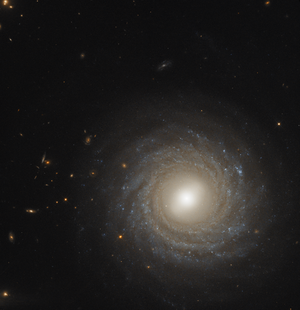NGC 7371
| Galaxy NGC 7371 |
|
|---|---|

|
|
| Taken using the Hubble Space Telescope | |
| AladinLite | |
| Constellation | Aquarius |
|
Position equinox : J2000.0 , epoch : J2000.0 |
|
| Right ascension | 22 h 46 m 03.7 s |
| declination | -11 ° 00 ′ 04 ″ |
| Appearance | |
| Morphological type | (R) SA (r) 0 / a: |
| Brightness (visual) | 11.6 mag |
| Brightness (B-band) | 12.5 mag |
| Angular expansion | 2 ′ × 2 ′ |
| Surface brightness | 13.0 mag / arcmin² |
| Physical data | |
| Redshift | 0.008950 +/- 0.000013 |
| Radial velocity | +2683 ± 4 km / s |
|
Stroke distance v rad / H 0 |
(125 ± 9) x 10 6 ly (38.2 ± 2.7) Mpc |
| history | |
| discovery | William Herschel |
| Discovery date | November 28, 1785 |
| Catalog names | |
| NGC 7371 • PGC 69677 • MCG -02-58-001 • 2MASX J22460372-1100038 • GC 4833 • H II 477 • h 2180 • NPM1G -11.0516 | |
NGC 7371 is a lenticular galaxy of type SB0-a in the constellation Aquarius on the ecliptic . It is estimated to be 125 million light years away from the Milky Way and has a diameter of about 70,000 ly.
In the same area of the sky are the galaxies NGC 7378 , NGC 7399 , IC 1451 , IC 1453 .
The object was discovered by William Herschel on November 28, 1785 .
